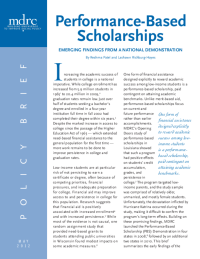Performance-Based Scholarships: Emerging Findings from a National Demonstration
Increasing the academic success of students in college is a national imperative. While college enrollment has increased from 5.9 million students in 1965 to 20.4 million in 2009, graduation rates remain low. Just over half of students seeking a bachelor’s degree and enrolled in a four-year institution full time in fall 2002 had completed their degree within six years. Despite the marked increase in access to college since the passage of the Higher Education Act of 1965 — which extended need-based financial assistance to the general population for the first time — more work remains to be done to improve persistence in college and graduation rates.
Low-income students are at particular risk of not earning a certificate or degree, often because of competing priorities, financial pressures, and inadequate preparation for college. Financial aid may improve access to and persistence in college for this population. One form of financial assistance designed explicitly to reward academic success among low-income students is a performance-based scholarship, paid contingent on attaining academic benchmarks. Unlike merit-based aid, performance-based scholarships focus on current and future performance rather than earlier accomplishments. They are paid directly to students rather than to institutions and supplement federal Pell Grants and state aid.
MDRC’s Opening Doors study of performance-based scholarships in Louisiana had shown that such a program had positive effects on students’ credit accumulation, grades, and persistence in college. Building on these promising findings, in 2008, MDRC launched the Performance-Based Scholarship (PBS) Demonstration, a study in six states that is testing whether different configurations of these scholarships in different locations and among different types of students would be equally effective in improving their outcomes.
This brief summarizes preliminary results from performance-based scholarship programs in Ohio, New York, and New Mexico, in addition to the original results in Louisiana. The results show modest but positive effects on important markers of academic progress, including increases in credits earned, greater impacts in the second term, and an increase in students’ abilities to meet end-of-term benchmarks during program terms. While the Louisiana program saw sizeable effects on rates of registration in virtually every term after random assignment, the early findings in Ohio, New York, and New Mexico have not found similar effects. In Ohio and New Mexico, students’ debt was reduced as a result of the scholarships.
The short-term results of the demonstration suggest that performance-based scholarships can move the dial on some important markers of academic success. If the programs can show lasting effects after the scholarships are no longer available — and impacts on persistence in college emerge in later terms — these scholarships could lead to higher graduation rates and translate into higher earnings. MDRC will follow these longer-range outcomes closely in Ohio, New York, and New Mexico in the coming years. In addition, forthcoming results from three more states in the PBS Demonstration — California, Arizona, and Florida — will add to the body of knowledge on the effectiveness of these scholarships in improving academic success for low-income students.






